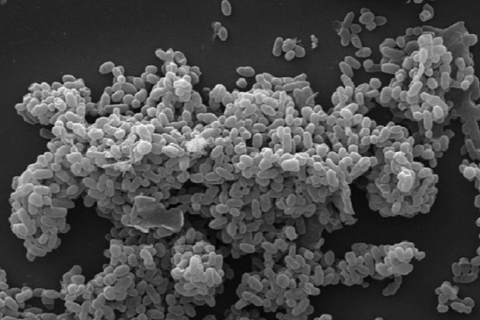Early life exposure to ‘forever chemicals’ in the environment permanently disrupts the gut microbiome in mice, contributing to the development of metabolic disease in later life, according to new research led by Penn State.

The results, published today (Aug. 14) in the journal Environmental Health Perspectives, suggest that human exposure to these chemicals during early childhood may be contributing to the recent epidemic of metabolic disorders, including obesity and type 2 diabetes among adults.
READ MORE: Microbes found to destroy certain ‘forever chemicals’
READ MORE: Two biological cleaners break down ‘forever chemicals’
The researchers focused specifically on 2,3,7,8-tetrachlorodibenzofuran (TCDF), a widespread persistent organic pollutant (POP) that is a byproduct of waste incineration, metal production, and fossil-fuel and wood combustion. TCDF accumulates in the food chain, and humans are primarily exposed through consumption of high-fat foods, such as meat, dairy products and some fish. Babies can be exposed through consumption of breast milk.
Negative health effects
“POPs are pervasive in the environment and nearly every living organism has been exposed,” said Andrew Patterson, John T. and Paige S. Smith Professor of Molecular Toxicology and of Biochemistry and Molecular Biology, Penn State. “The negative health effects of these chemicals are well documented and include birth defects and cancer. Our study is the first to suggest that early-life exposure to a certain POP, called TCDF, also disrupts the gut microbiome and is associated with metabolic disorders later in life.”
The team examined the effects of TCDF in two groups of mice — a test group, or those treated with TCDF and a control group, or those receiving no treatment. The team fed four-week-old mice from pills containing either 0.46 micrograms (µg) of TCDF or a control pill that did not contain any TCDF for five days. While 0.46 µg is higher than what is typically found in the diets of humans, it is not high enough to cause toxic illness.
“In our study we used a dose that is relatively high compared to typical human exposures; however, we can use this information to identify new toxicity high points, including in the gut microbiome, and begin to extrapolate what might happen at even lower doses. Of course, we also must consider how complex mixtures of these POPs interact with us and our microbial partners because a single exposure does not perfectly mimic real life scenarios.”
Indicators of health
Next, the researchers examined the animals’ gut microbiomes, along with several indicators of the animals’ health, including body weight, glucose tolerance, and the amounts of triglycerides in their livers and mucus in their feces, among other markers of metabolic disease. They collected these data immediately following the five-day course of TCDF, as well as three months after the last dose. In humans, these time points are equivalent to an infant and a young adult.
“We found that early life exposure to TCDF permanently disrupted the gut microbiomes of the wild-type mice,” said Yuan Tian, lead author and associate research professor, Penn State. “We also found that these mice had higher body weight and glucose intolerance at age four months.”
To further explore the effects of TCDF on the gut microbiome, the scientists gave mice without microbiomes intestinal microbiome transplants from the mice with TCDF-disrupted microbiomes and measured their health outcomes. They found that the mice with the transplants developed metabolic disorders, indicating that the altered microbiome is the cause of the metabolic disease.
Disturbances later in life
“These results suggest that early-life TCDF exposure may be causing the disturbances in gut microbiome function and health outcomes later in life, even well after the TCDF has been eliminated from the body,” Tian said.
She explained that the gut microbiome disturbances were marked by a decrease in certain bacterial species, including Akkermansia muciniphila, a bacterium that is also typically found in the human gut microbiome.
“This is important because Akkermansia is recognized as important for overall gut health, but now we know that it can be adversely affected by TCDF,” Tian said.
Probiotic restoration
To investigate the importance of Akkermansia muciniphila in influencing health outcomes, the team experimented with administering the bacterium as a probiotic to TCDF-treated mice. The probiotic restored the microbiome to its normal state.
“Our findings suggest that these bacteria are influenced by toxic exposure and play an important role in mediating health outcomes,” Patterson said. “It may be possible that with more research we could one day restore a person’s microbiome to its optimal state through supplementation with pre- and probiotics.”
Other Penn State authors on the paper include Jordan Bisanz, assistant professor of biochemistry and molecular biology; Imhoi Koo, assistant research professor; Iain Murray, assistant research professor; Shigetoshi Yokoyama, assistant research professor; Sergei Koshkin, assistant research professor; Bipin Rimal, graduate student; Wei Gui, research technologist; Shaneice Nettleford, graduate student; Fangcong Dong, postdoctoral fellow; Sandeep Prabhu, head, Department of Veterinary and Biomedical Sciences; and Gary Perdew, H. Thomas and Dorothy Willits Hallowell Chair in Agricultural Sciences. Other authors include Trenton Wolfe, graduate student, Montana State University; Peter Turnbaugh, professor of microbiology and immunology, University of California, San Francisco; and Seth Walk, professor of microbiology and immunology, Montana State University.
The U.S. National Institutes of Health, U.S. National Institute of Food and Agriculture and Pennsylvania Department of Health supported this research.







No comments yet